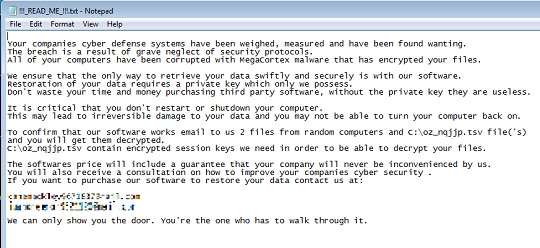Ransom.Win32.CORTEX.A
Windows


Threat Type: Ransomware
Destructiveness: No
Encrypted: No
In the wild: Yes
OVERVIEW
Dropped by other malware, Downloaded from the Internet
This Ransomware arrives on a system as a file dropped by other malware or as a file downloaded unknowingly by users when visiting malicious sites.
It drops files as ransom note.
TECHNICAL DETAILS
903,664 bytes
EXE
No
03 May 2019
Arrival Details
This Ransomware arrives on a system as a file dropped by other malware or as a file downloaded unknowingly by users when visiting malicious sites.
Installation
This Ransomware drops the following files:
- %System Root%\oz_nqjjp.log -> Contains list of files it was unable to encrypt
- %System Root%\oz_nqjjp.tsv -> Contains list of encrypted files with corresponding "session" keys
- %User Temp%\oz_nqjjp.dll -> Performs the encryption routine and deleted when no file is being encrypted
- %System Root%\!!!_READ_ME_!!!.txt -> Ransom note
(Note: %System Root% is the Windows root folder, where it usually is C:\ on all Windows operating system versions.. %User Temp% is the current user's Temp folder, which is usually C:\Documents and Settings\{user name}\Local Settings\Temp on Windows 2000, XP, and Server 2003, or C:\Users\{user name}\AppData\Local\Temp on Windows Vista, 7, and 8.)
It adds the following processes:
- %System%\rundll32.exe \?\%User Temp%\oz_nqjjp.dll,_command@16 Global\liboz_nqjjp -> Encrypts a number of files per instance
- vssadmin.exe delete shadows /all /for={Drive Letter} -> Used to delete volume shadow copies of affected drives
- cipher.exe /w:{Drive Letter} -> Used to delete free copies of affected drives
(Note: %User Temp% is the current user's Temp folder, which is usually C:\Documents and Settings\{user name}\Local Settings\Temp on Windows 2000, XP, and Server 2003, or C:\Users\{user name}\AppData\Local\Temp on Windows Vista, 7, and 8.)
Other Details
This Ransomware does the following:
- It requires the following condition for its proper execution:
- Specific time and date
- Base-64 coded argument
- Will be execute by its batch file component <- detected as Ransom.BAT.CORTEX.B
Ransomware Routine
This Ransomware avoids encrypting files with the following strings in their file name:
- .dll
- .exe
- .sys
- .mui
- .tmp
- .lnk
- .config
- .manifest
- .tlb
- .old
It avoids encrypting files found in the following folders:
- %Windows%
(Note: %Windows% is the Windows folder, where it usually is C:\Windows on all Windows operating system versions.)
It appends the following extension to the file name of the encrypted files:
- aes128ctr
It drops the following file(s) as ransom note:
- %System Root%\!!!_READ_ME_!!!.txt

SOLUTION
9.850
14.976.08
03 May 2019
14.977.00
04 May 2019
Step 1
Before doing any scans, Windows 7, Windows 8, Windows 8.1, and Windows 10 users must disable System Restore to allow full scanning of their computers.
Step 2
Note that not all files, folders, and registry keys and entries are installed on your computer during this malware's/spyware's/grayware's execution. This may be due to incomplete installation or other operating system conditions. If you do not find the same files/folders/registry information, please proceed to the next step.
Step 3
Restart in Safe Mode
Step 4
Search and delete these files
- %System Root%\!!!_READ_ME_!!!.txt
- %System Root%\oz_nqjjp.tsc
- %System Root%\oz_nqjjp.log
Step 5
Restart in normal mode and scan your computer with your Trend Micro product for files detected as Ransom.Win32.CORTEX.A. If the detected files have already been cleaned, deleted, or quarantined by your Trend Micro product, no further step is required. You may opt to simply delete the quarantined files. Please check this Knowledge Base page for more information.
Step 6
Restore encrypted files from backup.
Did this description help? Tell us how we did.

